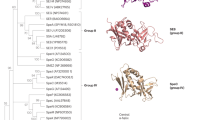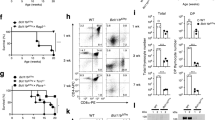Abstract
T cell antigen receptor ζ chain down-regulation and impaired in vitro T cell function have been described in cancer and autoimmune and infectious diseases. However, the immunological basis for this phenomenon is unknown. Sustained exposure to antigen and chronic systemic inflammation, factors shared by the various pathologies, might account for this phenomenon. We developed an in vivo experimental system that mimics these conditions and show that sustained exposure of mice to bacterial antigens was sufficient to induce T cell antigen receptor ζ chain down-regulation and impair T cell function, provided an interferon-γ-dependent T helper type 1 immune response developed. This indicates ζ chain down-regulation could be a physiological response that attenuates an exacerbated immune response. However, it can act as a 'double-edged sword', impairing immune responses to chronic diseases.
This is a preview of subscription content, access via your institution
Access options
Subscribe to this journal
Receive 12 print issues and online access
$209.00 per year
only $17.42 per issue
Buy this article
- Purchase on Springer Link
- Instant access to full article PDF
Prices may be subject to local taxes which are calculated during checkout







Similar content being viewed by others
References
Weiss, A. & Littman, D.R. Signal transduction by lymphocyte antigen receptors. Cell 76, 263–274 (1994).
Klausner, R.D., Lippincott-Schwartz, J. & Bonifacino, J.S. The T cell antigen receptor: insights into organelle biology. Annu. Rev. Cell Biol. 6, 403–431 (1990).
Mizoguchi, H. et al. Alterations in signal transduction molecules in T lymphocytes from tumor-bearing mice. Science 258, 1795–178 (1992).
Kane, L.P., Lin, J. & Weiss, A. Signal transduction by the TCR for antigen. Curr. Opin. Immunol. 12, 242–249 (2000).
Alberola-Ila, J., Takaki, S., Kerner, J.D. & Perlmutter, R.M. Differential signaling by lymphocyte antigen receptors. Annu. Rev. Immunol. 15, 125–154 (1997).
Finke, J.H. et al. Loss of T-cell receptor ζ chain and p56lck in T-cells infiltrating human renal cell carcinoma. Cancer Res. 53, 5613–5616 (1993).
Nakagomi, H. et al. Decreased expression of the signal-transducing ζ chains in tumor-infiltrating T-cells and NK cells of patients with colorectal carcinoma. Cancer Res. 53, 5610–5612 (1993).
Matsuda, M. et al. Alterations in the signal-transducing molecules of T cells and NK cells in colorectal tumor-infiltrating, gut mucosal and peripheral lymphocytes: correlation with the stage of the disease. Int. J. Cancer 61, 765–772 (1995).
Lai, P. et al. Alterations in expression and function of signal-transducing proteins in tumor-associated T and natural killer cells in patients with ovarian carcinoma. Clin. Cancer Res. 2, 161–173 (1996).
Kono, K. et al. Decreased expression of signal-transducing ζ chain in peripheral T cells and natural killer cells in patients with cervical cancer. Clin. Cancer Res. 2, 1825–1828 (1996).
Kurt, R.A., Urba, W.J., Smith, J.W. & Schoof, D.D. Peripheral T lymphocytes from women with breast cancer exhibit abnormal protein expression of several signaling molecules. Int. J. Cancer 78, 16–20 (1998).
Kuss, I., Saito, T., Johnson, J.T. & Whiteside, T.L. Clinical significance of decreased ζ chain expression in peripheral blood lymphocytes of patients with head and neck cancer. Clin. Cancer Res. 5, 329–334 (1999).
Healy, C.G. et al. Impaired expression and function of signal-transducing ζ chains in peripheral T cells and natural killer cells in patients with prostate cancer. Cytometry 32, 109–119 (1998).
Trimble, L.A. & Lieberman, J. Circulating CD8 T lymphocytes in human immunodeficiency virus-infected individuals have impaired function and downmodulate CD3 ζ, the signaling chain of the T-cell receptor complex. Blood 91, 585–594 (1998).
Zea, A.H. et al. Changes in expression of signal transduction proteins in T lymphocytes of patients with leprosy. Infect. Immun. 66, 499–504 (1998).
Maurice, M.M. et al. Defective TCR-mediated signaling in synovial T cells in rheumatoid arthritis. J. Immunol. 159, 2973–2978 (1997).
Liossis, S.N., Ding, X.Z., Dennis, G.J. & Tsokos, G.C. Altered pattern of TCR/CD3-mediated protein-tyrosyl phosphorylation in T cells from patients with systemic lupus erythematosus. Deficient expression of the T cell receptor ζ chain. J. Clin. Invest. 101, 1448–1457 (1998).
Genco, C.A. & Arko, R.J. Animal chamber models for study of host-parasite interactions. Methods Enzymol. 235, 120–140 (1994).
Houri-Haddad, Y., Soskolne, W.A., Halabi, A., Barak, V. & Shapira, L. Repeat bacterial challenge in a subcutaneous chamber model results in augmented tumour necrosis factor-α and interferon-γ response, and suppression of interleukin-10. Immunology 99, 215–220 (2000).
Franco, J.L. et al. Partial degradation of T-cell signal transduction molecules by contaminating granulocytes during protein extraction of splenic T cells from tumor-bearing mice. Cancer Res. 55, 3840–3846 (1995).
Caplan, S. & Baniyash, M. Normal T cells express two T cell antigen receptor populations, one of which is linked to the cytoskeleton via ζ chain and displays a unique activation-dependent phosphorylation pattern. J. Biol. Chem. 271, 20705–20712 (1996).
Caplan, S., Zeliger, S., Wang, L. & Baniyash, M. Cell-surface-expressed T-cell antigen-receptor ζ chain is associated with the cytoskeleton. Proc. Natl. Acad. Sci. USA 92, 4768–4772 (1995).
Bronstein-Sitton, N., Wang, L., Cohen, L. & Baniyash, M. Expression of the T cell antigen receptor ζ chain following activation is controlled at distinct checkpoints. Implications for cell surface receptor down-modulation and re-expression. J. Biol. Chem. 274, 23659–23665 (1999).
Valitutti, S., Muller, S., Salio, M. & Lanzavecchia, A. Degradation of T cell receptor (TCR)-CD3-ζ complexes after antigenic stimulation. J. Exp. Med. 185, 1859–1864 (1997).
D'Oro, U., Vacchio, M.S., Weissman, A.M. & Ashwell, J.D. Activation of the Lck tyrosine kinase targets cell surface T cell antigen receptors for lysosomal degradation. Immunity 7, 619–628 (1997).
Wells, M.A., Ennis, F.A. & Albrecht, P. Recovery from a viral respiratory infection. II. Passive transfer of immune spleen cells to mice with influenza pneumonia. J. Immunol. 126, 1042–1046 (1981).
Ada, G.L. & Jones, P.D. The immune response to influenza infection. Curr. Top. Microbiol. Immunol. 128, 1–54 (1986).
Gerhard, W., Mozdzanowska, K., Furchner, M., Washko, G. & Maiese, K. Role of the B-cell response in recovery of mice from primary influenza virus infection. Immunol. Rev. 159, 95–103 (1997).
Spellberg, B. & Edwards, J.E., Jr. Type 1/Type 2 immunity in infectious diseases. Clin. Infect. Dis. 32, 76–102 (2001).
Correa, M.R. et al. Sequential development of structural and functional alterations in T cells from tumor-bearing mice. J. Immunol. 158, 5292–5296 (1997).
Sussman, J.J. et al. Failure to synthesize the T cell CD3-ζ chain: structure and function of a partial T cell receptor complex. Cell 52, 85–95 (1988).
Enyedy, E.J. et al. Fcε receptor type I γ chain replaces the deficient T cell receptor ζ chain in T cells of patients with systemic lupus erythematosus. Arthritis Rheum. 44, 1114–1121 (2001).
Houri-Haddad, Y., Soskolne, W.A., Shai, E., Palmon, A. & Shapira, L. Interferon-γ deficiency attenuates local P. gingivalis-induced inflammation. J. Dent. Res. 81, 395–398 (2002).
Frucht, D.M. et al. IFN-γ production by antigen-presenting cells: mechanisms emerge. Trends Immunol. 22, 556–560 (2001).
Otsuji, M., Kimura, Y., Aoe, T., Okamoto, Y. & Saito, T. Oxidative stress by tumor-derived macrophages suppresses the expression of CD3 ζ chain of T-cell receptor complex and antigen-specific T-cell responses. Proc. Natl. Acad. Sci. USA 93, 13119–13124 (1996).
Almand, B. et al. Increased production of immature myeloid cells in cancer patients: a mechanism of immunosuppression in cancer. J. Immunol. 166, 678–689 (2001).
Kono, K. et al. Hydrogen peroxide secreted by tumor-derived macrophages down-modulates signal-transducing ζ molecules and inhibits tumor-specific T cell and natural killer cell-mediated cytotoxicity. Eur. J. Immunol. 26, 1308–1313 (1996).
Schmielau, J. & Finn, O.J. Activated granulocytes and granulocyte-derived hydrogen peroxide are the underlying mechanism of suppression of T-cell function in advanced cancer patients. Cancer Res. 61, 4756–4760 (2001).
Kusmartsev, S.A., Li, Y. & Chen, S.H. Gr-1+ myeloid cells derived from tumor-bearing mice inhibit primary T cell activation induced through CD3/CD28 costimulation. J. Immunol. 165, 779–785 (2000).
Baker, P.J., Evans, R.T. & Roopenian, D.C. Oral infection with Porphyromonas gingivalis and induced alveolar bone loss in immunocompetent and severe combined immunodeficient mice. Arch. Oral Biol. 39, 1035–1040 (1994).
Kesavalu, L., Ebersole, J.L., Machen, R.L. & Holt, S.C. Porphyromonas gingivalis virulence in mice: induction of immunity to bacterial components. Infect. Immun. 60, 1455–1464 (1992).
Rozdzial, M.M., Kubo, R.T., Turner, S.L. & Finkel, T.H. Developmental regulation of the TCR ζ-chain. Differential expression and tyrosine phosphorylation of the TCR ζ-chain in resting immature and mature T lymphocytes. J. Immunol. 153, 1563–1580 (1994).
Samelson, L.E., Weissman, A.M., Robey, F.A., Berkower, I. & Klausner, R.D. Characterization of an anti-peptide antibody that recognizes the murine analogue of the human T cell antigen receptor-T3 δ-chain. J. Immunol. 137, 3254–3258 (1986).
Harlow, E. & Lane, D. Using Antibodies: A Laboratory Manual (eds. Harlow, E. & Lane, D.) (Cold Spring Harbor Laboratory Press, Cold Spring Harbor, New York, 1999).
Leshem, B., Yogev, D. & Fiorentini, D. Heat inactivation of fetal calf serum is not required for in vitro measurement of lymphocyte functions. J. Immunol. Meth. 223, 249–254 (1999).
Leshem, B. & Brass, D. Mouse lymphoblasts lose their immunogenicity and susceptibility to specific cytotoxic T lymphocyte lysis during maintenance in culture. Immunology 95, 409–418 (1998).
Abdul-Hai, A. et al. Interleukin-7-enhanced cytotoxic T lymphocyte activity after viral infection in marrow transplanted mice. Bone Marrow Transplant. 19, 539–543 (1997).
Reed, J.L. & Muench, M. A simple method of estimating fifty percent endpoint. Am. J. Hyg. 27, 493–497 (1938).
Frolov, I., Houri-Hadad, Y., Soskolne, A. & Shapira, L. In vivo exposure to Porphyromonas gingivalis up-regulates nitric oxide but suppresses tumour necrosis factor-α production by cultured macrophages. Immunology 93, 323–328 (1998).
Acknowledgements
We thank N. Rosenheimer-Goudsmid for help with the FACS analysis. Supported by the Society of Research Associates of the Lautenberg Center, the Concern Foundation of Los Angeles, the Israel Academy of Sciences and Humanities, and the Joseph and Matilda Melnick Fund.
Author information
Authors and Affiliations
Corresponding author
Ethics declarations
Competing interests
The authors declare no competing financial interests.
Rights and permissions
About this article
Cite this article
Bronstein-Sitton, N., Cohen-Daniel, L., Vaknin, I. et al. Sustained exposure to bacterial antigen induces interferon-γ-dependent T cell receptor ζ down-regulation and impaired T cell function. Nat Immunol 4, 957–964 (2003). https://doi.org/10.1038/ni975
Received:
Accepted:
Published:
Issue Date:
DOI: https://doi.org/10.1038/ni975
This article is cited by
-
Exploration of biomarkers for systemic lupus erythematosus by machine-learning analysis
BMC Immunology (2023)
-
Specific inflammatory osteoclast precursors induced during chronic inflammation give rise to highly active osteoclasts associated with inflammatory bone loss
Bone Research (2022)
-
Validation of whole-blood transcriptome signature during microdose recombinant human erythropoietin (rHuEpo) administration
BMC Genomics (2017)
-
Immune biomarkers for chronic inflammation related complications in non-cancerous and cancerous diseases
Cancer Immunology, Immunotherapy (2017)
-
Neuraminidase-producing oral mitis group streptococci potentially contribute to influenza viral infection and reduction in antiviral efficacy of zanamivir
Cellular and Molecular Life Sciences (2015)



